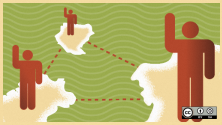It was an exciting year covering the ways open source software and open educational resources provide an interesting intersection of the maker movement, with the emphasis on coding and creating using open resources and tools. We have even seen activities at the highest level of government in regards to the use of open educational resources.
A better formula: Math software
Professor William Stein at the University of Washington told us about his creation of SageMath. "Before SageMath, we were using clunky, expensive, and incomplete tools—like Mathematica—that were closed source software, so we couldn't see how they worked or modify them to do what we really needed them to do," said Stein.
He wants SageMath to be a powerful tool for his students. He didn't intend to create a new tool, but in the process of helping his students, he wound up writing software that is now used by hundreds of thousands of students. You can read more about it in: Open source math software competes in the classroom.
Just when we thought we knew all about open mathematics software, Jason Baker wrote 3 open source alternatives to MATLAB. "MATLAB is prohibitively expensive for many people outside of an academic setting, where license fees for a single copy can reach into the thousands of dollars,” Baker said. In his article, he introduces us to GnuOctave, SciLab, and SageMath.
Teaching Python
What high school or college mathematics curriculum is complete without a programming course in Python? Brian Hall is an educator and developer from Hilo, and he share a wealth of resources in his article 11 resources for teaching and learning Python. Brian is keen to various learning styles, varying levels of knowledge, and a field of study that changes daily. His article provides a succinct compendium of Python teaching and learning resources.
Getting student started on open source tools
Once you have gotten your students writing code, you will need a place to store and share your work. Michael Taggart, director of Technology at The Mirman School for Gifted Children, wrote in Using Git in the classroom how he helped middle school students become acquainted with complex operations. "In my advanced programming classes, I've discovered that middle school students are capable of far more complex operations than we often suspect. In many cases, they're wholly capable of using industry-standard tools to produce remarkable work," he said. His article is a great resource for teachers and students who want an introduction to version control systems.
In the same vein, Chris Aniszczyk, interim executive director (interim) at Cloud Native Computing Foundation, wrote How students can get started contributing to open source software. Drawing on his own experience, he shares how getting involved with open source is a great way to improve your programming skills. In his article, he cites a number of projects that welcome new programmers. The list includes Google's Summer of Code, Outreachy, and Facebook Open Academy, among others.
Tackling open source projects
After your programming skills are honed, you can benefit from another of this year's top articles, GPIO Zero and Raspberry Pi programming projects, written by Community Moderator Ben Nuttall. "One of the most exciting starter activities to do with a Raspberry Pi is something you can't do on your regular PC or laptop—make something happen in the real world, such as flash an LED or control a motor," he said. Ben's article is full of great ideas and code snippets that will have you well on your way to mastering programming the Raspberry Pi.
If you are a teacher and you would really like to learn about how you can use the Raspberry Pi in your classroom, Ben Nuttall wrote another great article, Picademy: Free professional development for teachers from the Raspberry Pi Foundation. Picademy is an educational initiative for teachers from the Raspberry Pi Foundation. It includes a free, two-day professional development course. In 2016, the course was held in April at the Computing History Museum in Mountain View, California.
Schools adopt open source
We had two great articles about public schools who are actually using Linux computers and open source software in the classroom. I interviewed Stu Keroff, who is technology coordinator at the Community School of Excellence, a middle school in St. Paul, Minnesota. Stu is the founder of the CSE Asian Penguins, the first and only Linux user group in a Hmong charter school. In the article, Asian Penguins turn program into a Linux success, Stu Keroff tells how his passion for using Linux and open source software fuels his work with this unique group of students.
In another article, Charlie Reisinger, technology director for the Penn Manor school district, writes How our high school replaced IRC with Mattermost covering the need for a more social chat client led to the school's adoption of this messaging platform. The school district is the bellwether of open source in education, and this article provides key insights about how open principles point the way forward in education.
In February 2016, Acting U.S. Secretary of Education John King said, "Openly licensed educational resources can increase equity by providing all students, regardless of zip code, access to high quality learning materials that have the most up-to-date and relevant content." With that thought in mind, I authored 7 Resources for Open Educational Materials. The article offers a concise list of resources for K-12 and higher education institutions, teachers and students.







2 Comments